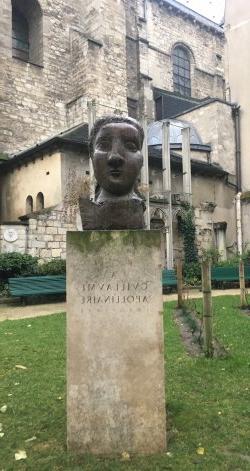COLLABORATIONS – Around 朵拉 – by 玛丽·安·考斯
发布: 客人的文章

I am looking at a head, marked “to Apollinaire, 诗人王子,” and knowing it is in fact the likeness of one of Picasso’s mistresses, the photographer 朵拉. So, let me think of this as a three-way collaboration: with Apollinaire, whose name figures 在这里, 朵拉, whose head figures 在这里, 和毕加索, whose art figures 在这里.
This commemorative head is the substitution of a sometimes beloved mistress photographer for the always beloved poet whose head Picasso didn’t want to put 在这里, 好像 he were — which he was, 当然——死了. That was because that great artist had a phobia about death, and to have put the poet he so loved (indeed he did, even speaking to Apollinaire on his own death bed) into a memorial stone would have been both traumatic and terrible. Better confuse passersby into thinking the poet must have had a very feminine face, to have looked like that.
Patti Smith was once taken in by it, on her visiting to this square of Laurent Prache, behind the Eglise of St-Germain-des-prés when she was staying at that hallowed by the epochs Café de Flore, as described in her recent book 奉献.… I love writing about this in my just published Creative Gatherings: Meeting Places of Modernism, 好像, in some impossible way, I could be community-gathering with these writers and artists and photographers.
And why not imagine a many-way meeting with those we love to read about and look along with and with whom we try to remember epochs. I love the history of the head: since Aristide Maillol had placed a patina on his statues by pissing upon them, Apollinaire had pissed upon one head of 朵拉, 把它变成绿色, so this is the second head. And then, a few years ago, this head was stolen, and recovered alongside a Breton road, mysteriously. Everything about this head-spinning tale is mysterious.
Is not that, in fact, the most real of collaborative gatherings? The one we remember and re-dwell within? It is not a memorial but a memory, vivid beyond telling, better in the retelling, so I am considering a re-collaboration, heightened by its momentary nature.
Who didn’t love and love loving Picasso more than his mistresses, 因为我们, the true appreciators of his art, don’t have to be involved with his infidelity. He is t在这里 for us always, 永久, however we look and care and judge his differing stages and carings: the genius perseveres. 对我来说, that is the most true of workings-together, writing about what he painted about, seeing through his brush.
Because I love digressions, perhaps most of all, let me remind myself that Leonardo da Vinci, on whom I have just had the joy of writing for the Gagosian Quarterly, painted very often with his fingers instead of a brush, 如此可爱的, like his mirror writing and his left-handedness. And so I come back to 朵拉, around whom I am spinning this collaborative tale, who painted her rather awkward paintings — except for the landscapes around Ménerbes, which I love — with her left hand.
对我来说, collaboration is indeed about looking, through and with and around…so, “around 朵拉” I have called this reflection on all this seeing together. I have spent my life collaborating with those I have written about and thought through, so, 我希望, 思考伴随着. So, perhaps more than a three-way collaboration, as I initially thought, 在这里, I am celebrating a four-way collaboration, 尽我所能.
— 玛丽·安·考斯 is Distinguished Professor Emerita and Resident Professor of Comparative Literature, 英语, and French at the Graduate School of the City 大学 of New York. Her many areas of interest in twentieth-century avant-garde literature and art include Surrealism, poets René Char and André Breton, Virginia Woolf and the Bloomsbury group, and artists Robert Motherwell, 约瑟夫·康奈尔, 和毕加索.
